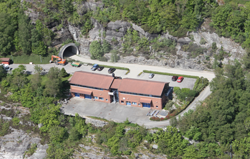Norway’s Green Mountain data centre
The Green Mountain data centre in Norway lays claim to being the world’s greenest data centre. Green Mountain’s Jonathan Evans, on a recent visit to Dublin, talked to Owen McQuade about what is probably the most energy efficient and innovative facility of its type.
Perhaps Green Mountain’s mission statement best sums up what it is about: “In a mountain, by a cold fjord, you find the world’s greenest data centre for secure data storage and energy-demanding server solutions.” The data centre is being developed by Norway’s Peter Smedvig. His Norwegian shipping family sold off all their shipping and oil industry-related interests for $1 billion and now look to invest in what Evans describes as “strategic long-term investments for future generations of his family.” With data centres being very capital-intensive, having such a strong private investment fund has enabled Green Mountain to build out a new data centre with all the infrastructure in place and then look for tenants. Often, in Evans’ experience, the investment lags behind customer requirements.
The data centre is on the site of a former high security NATO munitions storage facility, with 21,000m2 of floor space inside the mountain near the city of Stavanger. When NATO vacated the facility, it was leased to the local community for a peppercorn rent. The community was concerned about the long-term use of the facility and were happy to lease it to Smedvik on a renewable 100-year lease, thus securing a long-term tenant which would bring quality technology jobs to the area.
The data centre is built into a mountain at a depth of 100 meters which means that it is well protected from the external environment. The fjord is not tidal and there is minimal flood risk.
In addition to the physical attributes of being located inside a mountain, a number of external factors also make the facility siting ideal. Norwegian electricity is from mostly renewable sources with nearly all the country’s electricity coming from hydro-electric sources. The electricity is also competitive with European prices and long-term contracts also available for up to 10 years.
The electric power is consumed with a data centre to power the servers. An additional amount of energy is consumed to cool the servers. The measure of the energy efficiency is the power usage effectiveness (PUE), which is the ratio of total power consumption for the facility divided by the consumption of power by the servers. PUE ratios are typically 1.6 but the Green Mountain facility’s PUE is 1.2.
Energy costs are significant for the running of data centres. Green Mountain utilises cooling from the fjord which has water at 8˚C available all year round. Using a siphon system, cool water is withdrawn from the fjord at a depth of 100 metres and piped through a heat exchanger to provide cooling water to the facility.
Another innovation that brings environmental benefits is the fire suppression system. Rather than use environmentally unfriendly fire suppressant gases, a hypoxic air venting system is used.
This maintains the oxygen content of the air in the facility at 15 per cent, much lower than the usual 21 per cent. The system removes the oxygen and replaces it with nitrogen. At this lower level of oxygen, it is possible to still breathe but it will not support combustion and common materials cannot ignite or burn.
Green Mountain’s unique location allows it to access cheap renewable energy and use the fjord as a source of cheap coolant. It is perhaps a little ironic that it also benefits from the oil and gas infrastructure built up over that past three decades.
The telecoms infrastructure that links the area to the outside world has been built on the back of Norway’s oil and gas industry. The data centre’s latency connectivity to London is 6.8ms which is equivalent to that between Dublin and London. Whilst this rules out investment banking, which requires a much lower latent connectivity of around 1.0 ms, it is adequate for most applications.
The facility’s construction is in the final stages and the first client servers will come online in January 2013 in what will be a unique site for data storage.







